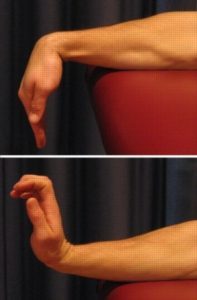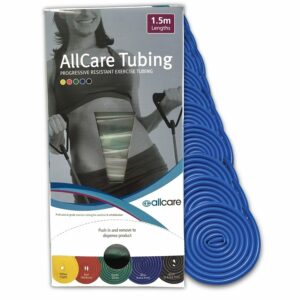Ulna Fracture
Updated:
(Also known as an Olecranon Fracture, Fractured Ulna, Broken Ulna)
What is an ulna fracture?
An ulna fracture is a relatively common condition characterised by a break in one of the long bones of the forearm, known as the ulna (figure 1).

The forearm comprises of 2 long bones, known as the radius and the ulna, which are situated beside each other (figure 1). The ulna bone lies on the inner aspect of the forearm (i.e. the little finger side) and forms joints with the humerus (at the elbow), the radius (near the elbow and wrist) and several small carpal bones in the wrist (figure 1).
During certain activities such as a fall onto the outstretched hand stress is placed on the ulna bone. When this stress is traumatic and beyond what the bone can withstand a break in the ulna may occur. This condition is known as an ulna fracture.
An ulna fracture is common among the elderly (especially those who are prone to falls), but can also occur in the younger patient or athlete. Often a fracture to the ulna occurs in combination with other injuries such as a sprained or dislocated wrist or elbow, a fractured radius (Colles’ fracture), or other fractures of the hand, wrist or forearm (such as following trauma).
Ulna Fractures can vary in location, severity and type including avulsion fracture, stress fracture, medial epicondyle fracture, olecranon fracture, displaced fracture, un-displaced fracture, angulated fracture, greenstick, comminuted etc.
Causes of an ulna fracture
An ulna fracture most commonly occurs due to a traumatic weight bearing force through the wrist, forearm, or elbow such as fall onto the outstretched hand or forearm, or a fall onto the point of the elbow. This may occur with any fall, but is particularly common in sports such as skateboarding or snowboarding (particularly in icy conditions) where a fall onto a hard surface is unforgiving.
Ulna fractures may also occur due to a direct blow to the forearm from a moving object or due to collision with a stationary object (such as road / traffic accidents or contact sports). Ulna fractures are relatively common in other sports whereby a fall onto a hard surface is common such as ice skating, cycling, basketball and netball. Falls or collisions in running and jumping sports involving change of direction such as football, soccer and rugby may also cause these injuries.
Signs and symptoms of an ulna fracture
Patients with an ulna fracture typically experience a sudden onset of sharp, intense wrist, forearm or elbow pain at the time of injury. This often causes the patient to cradle the affected arm so as to protect the injury. Pain is usually felt on the front, back or little finger side of the forearm, wrist or elbow and can occasionally settle quickly leaving patients with an ache at the site of injury that is particularly prominent at night or first thing in the morning.
Patients with an ulna fracture may also experience swelling, bruising and pain on firmly touching the affected region of the bone. Pain may also increase during certain movements of the wrist or elbow, when twisting the forearm, gripping or during weight-bearing activity (such as pushing) through the affected wrist. Occasionally, pins and needles or numbness may be present in the forearm, hand or fingers. In severe ulna fractures (with bony displacement), an obvious deformity may be detected.
Diagnosis of an ulna fracture
A thorough subjective and objective examination from a physiotherapist or doctor is essential to assist with diagnosis of an ulna fracture. An X-ray is required to confirm diagnosis. Further investigations such as an MRI, CT scan or bone scan may be required, in some cases, to assist with diagnosis and assess the severity of injury.
Treatment for an ulna fracture

Members Only ContentBecome a PhysioAdvisor Member to gain full access to this exclusive content. For more details see Become a Member. Already a member? Login Now
Prognosis of an ulna fracture
Patients with a fractured ulna usually make a full recovery with appropriate management (whether surgical or conservative). Return to activity or sport can usually take place in weeks to months and should be guided by the treating physiotherapist and specialist. In patients with severe injuries involving damage to other bones, soft tissue, nerves or blood vessels, recovery time may be significantly prolonged.
Physiotherapy for an ulna fracture
Physiotherapy treatment is vital in all patients with a fractured ulna to hasten healing and ensure an optimal outcome. Treatment may comprise:
- the use of a sling
- soft tissue massage
- joint mobilisation
- dry needling
- electrotherapy (e.g. ultrasound)
- taping or bracing
- ice or heat treatment
- the use of a compression bandage
- exercises to improve strength, flexibility and function
- education
- activity modification
- a graduated return to activity plan
Other intervention for an ulna fracture
Despite appropriate physiotherapy management, some patients with this condition do not improve adequately and may require other intervention. The treating physiotherapist or doctor can advise on the best course of management when this is the case. This may include further investigations such as X-rays, CT scan, MRI or bone scan, extended periods of plaster cast immobilisation or referral to appropriate medical authorities who can advise on any intervention that may be appropriate to improve the fractured ulna.
Occasionally, patients who are initially managed conservatively may require surgery to stabilise the fracture and a bone graft to aid fracture healing.
Exercises for an ulna fracture
The following exercises are commonly prescribed to patients with a fractured ulna following confirmation that the fracture has healed (or following internal fixation surgery to stabilise the fracture) and provided the orthopaedic specialist has indicated it is safe to begin mobilisation. You should discuss the suitability of these exercises with your physiotherapist prior to beginning them. Generally, they should be performed 3 times daily and only provided they do not cause or increase symptoms.
Your physiotherapist will advise when you can commence the initial exercises and progress to the intermediate and advanced exercises. Generally, the addition of exercises or progression to more advanced exercises should take place gradually provided there is no increase in symptoms.
Initial Exercises
Elbow Bend to Straighten
Bend and straighten your elbow as far as you can go without pain, ensuring you feel no more than a mild to moderate stretch (figure 2). Begin with 5 repetitions and build up to 20 over a number of days, provided there is no increase in symptoms.

Wrist Bends
Begin this exercise with your forearm supported by a table or bench and your wrist and fingers over the edge (figure 3). Slowly bend your wrist forwards and backwards as far as you can go without pain and provided you feel no more than a mild to moderate stretch. Begin with 5 repetitions and build up to 20 over a number of days, provided there is no increase in symptoms.


Members Only ContentBecome a PhysioAdvisor Member to gain full access to this exclusive content. For more details see Become a Member. Already a member? Login Now
Intermediate Exercises

Members Only ContentBecome a PhysioAdvisor Member to gain full access to this exclusive content. For more details see Become a Member. Already a member? Login Now
Advanced Exercises

Members Only ContentBecome a PhysioAdvisor Member to gain full access to this exclusive content. For more details see Become a Member. Already a member? Login Now
Rehabilitation Protocol for an Ulna Fracture

Members Only ContentBecome a PhysioAdvisor Member to gain full access to this exclusive content. For more details see Become a Member. Already a member? Login Now
 Physiotherapy products for an ulna fracture
Physiotherapy products for an ulna fracture
Some of the most commonly recommended products by physiotherapists to hasten healing and speed recovery in patients with an ulna fracture include:
To purchase physiotherapy products for a fractured ulna click on one of the above links or visit the PhysioAdvisor Shop.
 Other Exercises
Other Exercises
- Wrist Flexibility Exercises.
- Wrist Strengthening Exercises.
- Elbow Flexibility Exercises.
- Elbow Strengthening Exercises.
- Arm Strengthening Exercises.
- Arm Stretches.
 Find a Physio for an ulna fracture
Find a Physio for an ulna fracture
Find a Physiotherapist in your local area who can treat an ulna fracture.
 More information
More information
- Learn when to use Ice or Heat.
- View detailed initial injury management advice and the R.I.C.E. Regime.
- View comprehensive physiotherapy information on Elbow Taping and Wrist Taping.
- Explore why your injury may not be improving.
- Read our Elbow Diagnosis Guide.
- Learn about Mindfulness and how it can help your state of mind and injury.
Become a PhysioAdvisor Member
-
 Individual Membership (12 Months)$59.95 for 1 year
Individual Membership (12 Months)$59.95 for 1 year -
 Individual Membership (3 Months)$39.95 for 3 months
Individual Membership (3 Months)$39.95 for 3 months -
 Individual Membership (Yearly)$49.95 / year
Individual Membership (Yearly)$49.95 / year -
 Individual Membership (Monthly)$15.95 / month
Individual Membership (Monthly)$15.95 / month
+ 6 References
PhysioAdvisor relies on credible scientific sources (ideally from systematic reviews of high quality, randomised controlled trials, when available) to guide our content creation. Read about our sourcing guidelines and how we create trusted content via our editorial policy.
- Brukner et al (2012). Brukner & Khan’s clinical sports medicine (4th ed.), 407-8. Australia: McGraw Hill Education.
- Makhni M.C., Makhni E.C., Swart E.F., Day C.S. (2017) Radius and Ulna Shaft Fractures. In: Makhni M., Makhni E., Swart E., Day C. (eds) Orthopedic Emergencies. Springer, Cham.
- Gray HFRS, Gray’s Anatomy 15th edition, New York, NY: Barnes & Noble,2010. p120-126
- Duckworth AD, Clement ND, Aitken SA, Court-Brown CM, McQueen MM. The epidemiology of fractures of the proximal ulna. Injury. 2012 Mar 1;43(3):343-6.
- Radius and Ulnar Shaft Fractures (2019). orthobullets.com/trauma/1025/radius-and-ulnar-shaft-fractures medicalnewstoday.com/articles/320655.php.
- Adult Forearm Fractures (2011). orthoinfo.aaos.org/en/diseases–conditions/adult-forearm-fractures/.

Link to this Page
If you would like to link to this article on your website, simply copy the code below and add it to your page:
<a href="https://physioadvisor.com.au/injuries/elbow-forearm/ulna-fracture”>Ulna Fracture – PhysioAdvisor.com</a><br/>PhysioAdvisor offers detailed physiotherapy information on an ulna fracture including: causes, symptoms, diagnosis, treatment, exercises, physiotherapy products and more...
Return to the top of Ulna Fracture.










